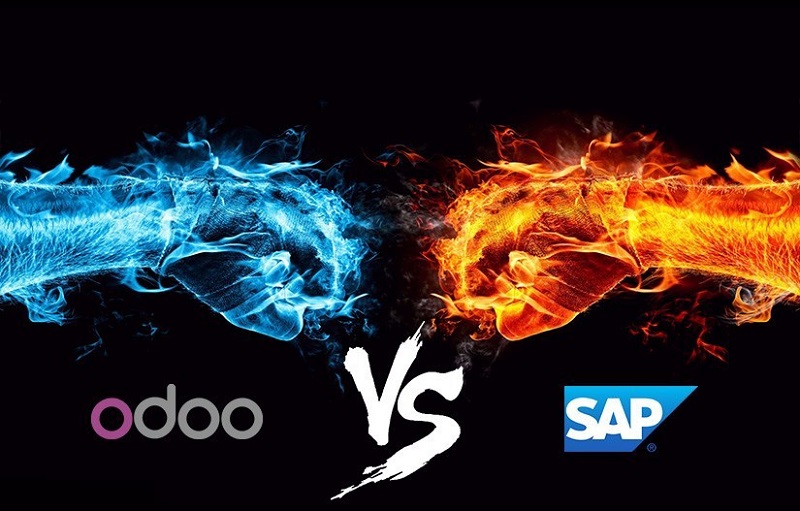Related Articles
In this day and age, there are a handful of enterprise resource planning (ERP) software products that’s available in the market for enterprises. SAP vs Odoo which one is better for our enterprise?
There was a time where SAP ruled this market with their ERP software solutions, but its glory days were short-lived because of the open-source products that were introduced into the market.
One excellent example of an open-source product is OpenERP. It was launched and announced back in 2010 which then evolved into Odoo.
Nowadays a software for business is more than just an ERP because of the number of functions that regularly get launched and integrated.
There are several cloud ERP software solutions available in the market that can manage every area of business.
ERP software can manage sales, marketing, inventory, warehouse management, finance management, and even the manufacturing processes
There are three popular ERP software solutions available for business enterprises. These include SAP, Oracle, and Odoo. Now, the question is, which one would best fit you and your company?
If you are thinking about integrating an ERP system into your company, then you have three excellent choices. In this blog, we will give you a comparison of the products and their packages, particularly Odoo and SAP to help you decide which one would best suit you.
For the purposes of this discussion, we will be talking about SAP vs. Odoo. Let’s begin!
SAP vs Odoo: Comparison of Features

First thing’s first, the functionality of an ERP solution should be the first thing you should look at. SAP stands out from the rest because it is built to fit into enterprise software. What that means is that it has to be set up specifically for each business process and system within that enterprise.
Let’s go through each of the ERP products so that you have a better idea of which one you should go for.
SAP Business One
Here are the features of SAP Business One:
- SAP is built to fit into ERP software. It has to be set up and customized for each business process and systems. And it also has a product specifically made to cater to SME’s known as SAP Business One. It’s very easy to use and it’s quick to install and doesn’t need much customization.
- SAP is also backward compatible which is one of the best benefits and features of the SAP products. They don’t require migration of data or codes every single time a new version is deployed. This puts their users at ease because they don’t have to worry about the updates and how to integrate them. This makes SAP different from other ERP solutions in the market.
- When it comes to cost SAP isn’t that much cheaper compared to the other software. The SAP Business One is a notch more expensive and the price does rise for every employee added. The cost for SAP Business One is one of its major drawbacks and most likely it’s the only setback for it.
- SAP has been in the business for a while now and because of this, the bugs that have been encountered by its users have already been fixed. Presently it has just a few bugs or none at all. The developers regularly remove the bugs within the systems to make sure it runs smoothly for their users.
Odoo Enterprise Resource Planning
Odoo is a popular ERP solution that’s readily available in the market. Let’s talk about its unique functionalities:
- Odoo is an all-inclusive system just like SAP ERP. Its business applications have modules for almost every function or system of a company or organization. It has more than 2 million users wherein the majority of its users are small to medium-sized enterprises. There are also a handful of big companies and enterprises that uses Odoo but that’s not what we’re talking about here. I just wanted to share that tidbit so, that you know that this product is used widely in the market. They also have 730 partners in their roster as well.
- Odoo however, unlike SAP isn’t backward compatible. When they release a new version or an update you do have to migrate the entire code and data. This can be inconvenient because the releases of the new versions can at times come out often and regularly.
- Odoo is an established software but there can be a few bugs that you may encounter. After the 8th release, the developers have begun fixing the bugs within its systems which is one of the reasons it may require a little fine-tuning right after you implement it within your organization.
- Odoo is available for a reasonable price especially when it’s compared to SAP Business One. You do have to pay for its services per user-based, but it is still not as costly as SAP. For example, if you have 50 users for SAP Business One that would cost you an estimated amount of 280,000 USD for 5 years while for the same conditions and or arrangements, Odoo would only charge you 75,000 USD. That’s a HUGE difference.
Whether or not you are outgrowing your old framework, or you need to replace your entry-level software, deciding on an ERP that will perfectly fit your organization is like moving the foundations of your house.
Your decision can massively affect your future. That’s why your choice and decision on which ERP solution you will go for should be based on knowledge and cost-effectiveness.
When Odoo was initially announced into the marketplace, SAP was the undisputed leader because it had a majority of the shares in the enterprise resource planning software solutions industry.
It controlled at that time around 6% of the market. But then SAP was restrained by the rest of the enterprise community.
SAP was mainly used and implemented by large enterprises because its application and maintenance cost was massive. SAP was beyond the financial reach of small-scale businesses which caused them to be used only by big brands This restricted the market reach of SAP and the ERP community until Odoo was announced – which changed the environment of the ERP industry.
Odoo carved its way into the ERP community and created its following within the SME’s and big business enterprises.
Because it’s an open-source system, it gave its users the freedom to implement an endless number of customizations to make it fit their user’s business needs and requirements.
This also made it easier to apply its modules in comparison to the software of SAP. With this, Odoo gained that attention of the market in no time and picked up quite a distinction within the SME’s which SAP just couldn’t do.
Also, Odoo offered a massive number of modules that offered an extensive number of functionalities and benefits which is what any SME could have asked for. With the latest releases of Odoo, their new features and benefits are being introduced to the market make it more and more prominent and sought after.
Large brands and enterprises are now stepping into the light of Odoo and have begun integrating and implementing it for their businesses, because of the flexibility and cost-effectiveness that Odoo offers.
Although SAP is still one of the leading pillars in the enterprise resource planning market, Odoo is quickly gaining traction and is spreading its awareness and extensiveness.
Odoo ERP may end up becoming the biggest competitor of SAP, albeit differently, targeting a wholly different set of customers.
Odoo envisions providing a comprehensive business tool that is easy to use and can be integrated with several suits of modules that fulfills their users and their business needs.
It aims to give millions of enterprises quick and simple access to the software which would then help develop and extend their business portfolio and effectively manage their tasks, features, and functions.
Odoo has 30 main modules or applications that are regularly updated. It also employs more than 1500 people.
It’s a community of members from functional experts to technical members that greatly contribute to newer apps that covers a wide range of assorted business needs. Up to now, there are around more than 16,000 applications that cover a variety of business requirements or needs.
Odoo is considered as the most installed business application tool in the world with its “On-premise” offer. It is used by more than 3.7 million clients whose enterprises range from new businesses to established undertakings.
SAP vs Odoo: Conclusion
Keeping in mind the factors we mentioned above, we have concluded, which is SAP Business One is still one of the most comprehensive ERP solutions available in the market if the cost is not an issue or a problem for you.
But if you want a software that is similarly functional that’s available at an affordable rate and you’re comfortable with doing some of the customizations and modifications then Odoo would be your best choice.
These are just our opinions and you may have a different perspective based on your own experience and business needs. Each software has its benefit and is by no means inferior to each other.
But if we are basing it on the same functionality and cost-effectiveness then some would be a tad bit better but only in specific areas.
At the end of the day, SAP is still one of the world’s largest provider for the enterprise software industry. Their products are matured and established enough to be able to handle the most complicated requirements for big brands and enterprises.
The offer of SAP Business One may be good but it is not flexible enough to handle the same kind of complicated business needs and or processes.
While Odoo is not as old or as established as SAP to be able to handle customized and rigorous requirements for large businesses it is a great alternative for SME’s who can’t afford a large budget for customizations and software that can be deployed quickly.
But Odoo’s modular software is one of it’s best and winning features. If you are an SME that is looking for an ERP at a reasonable price, then you should seriously consider Odoo.
SAP is a large business in itself and they also have a large organization to back it up that dwarfs their organization.
They have a massive community of trainers, implementers, developers, consultants, analysts, and partners, etc. SAP is made for multi-national enterprises and it has an incredibly wide range of offerings. The multi-currency feature of SAP alone can do more than the whole entirety of the Odoo product.
But because SAP is made for large corporations the implementations are costly. The maintenance and support needed to run and operate SAP for these corporations are extensively and comparatively extremely high.
While Odoo is a small software and it is open-sourced, anybody can understand and comprehend the entire system. You can have only one person to interact with all the modules needed for that business.
It is easy to start and all you have to do is download and install it. which makes this a great option for a startup business that SAP can’t do.
It is impossible to compare Odoo and SAP because they are both made to serve a different market. They may have similarities, but their intended audiences are vastly different.




